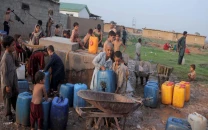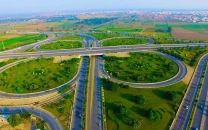Encroachments heighten threat of urban flooding
Illegal constructions, drain blockages have reduced floodplains, impeding the natural flow of water in low-lying areas

While climate change can be considered the obvious reason behind extreme weather patterns, the scale of damage reported across multiple major cities across Punjab in the aftermath of the recent monsoon rains appears to have its roots in something much more sinister.
According to reports received by the Express Tribune, over 829 illegal encroachments have been recorded on rivers, streams, and other natural water passages across the province, obstructing the flow of water. Multan Zone had the highest number of encroachments, 676, while Sahiwal, Bahawalpur, and Dera Ghazi Khan divisions recorded 153 encroachments. These encroachments have intensified the risk of urban flooding in low-lying areas.
Under the Irrigation, Drainage and River Act 2023, interfering with natural waterways or undertaking unauthorized construction is a punishable offense. However, enforcement on the ground remains weak. Experts are of the opinion that residential and commercial construction near rivers has significantly reduced floodplains, impeding the natural flow of water.
Over 114 people have lost their lives while hundreds of others have been injured due to heavy monsoon rains and floods hitting Punjab over the past one month. Affected districts include Chakwal, Rawalpindi and Mandi Bahauddin, where critical infrastructure has also suffered major damage.
Urban planning expert Sani Zahra stated that the primary reason behind flooding in major cities was their outdated and insufficient sewerage system. “For example, in Lahore, more than 40 per cent of drainage lines are either blocked or inadequate for the growing population while several drains have also been overtaken by illegal construction, causing rainwater to accumulate on the streets and roads,” noted Zahra.
Conversely, Dr Zulfiqar Ali, an environmentalist, noted that due to climate change, monsoons had become more intense. “Rising temperatures increase atmospheric moisture, leading to more frequent cloudbursts and heavy rains. Additionally, more than 7,000 glaciers in the north are rapidly melting, causing flash floods and surges in streams and rivers. Rampant deforestation and unplanned construction in hilly areas have further intensified flooding. Over the last two decades, Punjab has lost 30 per cent of its forest cover, resulting in soil erosion and increased river silt, which narrows the waterways, exacerbating flooding,” explained Dr Ali.
Between 2020 and 2025, more than 400 people lost their lives in Punjab due to rain and flood-related incidents, with financial losses estimated to exceed Rs75 billion. The most devastating year was 2022, when 15 districts were affected, 223 deaths were reported, and damages surpassed Rs200 billion. Many believe that 2025 is proving to be yet another disastrous year after 2022, with extreme weather patterns worsened by human negligence.
Hence experts advocate the need for both short and long-term measures to address the climate crisis, including the removal of encroachments from water channels, installation of modern drainage systems, reforestation, and climate-resilient disaster management plans. Meanwhile, the Punjab government has initiated work on integrated sewerage and flood drainage systems in 189 cities, with an allocation of Rs500 billion.
Syed Zahid Aziz, Head of the Punjab Municipal Development Fund Company, claimed that 13 rainwater storage ponds were being built in Lahore to raise groundwater levels. “Additionally, separate pipelines for sewerage and rainwater are being laid, with the new systems in Lahore capable of handling up to 200mm of rainfall,” informed Aziz.























COMMENTS
Comments are moderated and generally will be posted if they are on-topic and not abusive.
For more information, please see our Comments FAQ